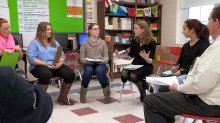A Town Helps Transform Its School
A low-performing rural school in New Hampshire reached out to the local community for help turning things around.
For years, residents in the small, rural community of Pittsfield, New Hampshire, fretted over the state of Pittsfield Middle High School, their only middle and high school. Ranked the fifth-lowest-performing high school in New Hampshire, the 300-student school struggled with attendance, discipline, and general student disengagement. Problems deepened when the neighboring town of Barnstead stopped sending kids to the school, resulting in a 40 percent drop in enrollment and a funding cut from the state.
“Every week parents told me, ‘You’ve got to do something about the high school,’” recalls John Freeman, who has been the superintendent since 2008. “It could not remain as it was because it wasn’t getting results needed by our students. It wasn’t creating value for the community.”
But moving the needle on deep-seated problems like attendance and school discipline requires buy-in from the community and a willingness to change the way things have been done in the past. The changes in the school system needed to be fundamental—and calibrated specifically to the needs of the local population.
So Freeman set up tables at long-standing local events like Old Home Day and the Rotary Club’s Hot Air Balloon Rally, attended civic meetings, and hosted public forums, all to ask community members: What did they want in their school? What should it look like?
The bottom-up plan that developed from that process focused on tangible, realistic goals that would confront widespread disengagement by giving students and community members more opportunities to express themselves and to take ownership of the school. These changes are now readily noticeable in the Site Council, a governing body that gives students and residents a say on the school’s rules and regulations, and the Justice Committee, where students help each other resolve conflicts to reduce suspensions and detentions. And students are now able to choose how they want to demonstrate mastery of learned material.
While early results after these changes were promising, Pittsfield Middle High School is still experiencing mixed outcomes academically. But in just a few years, the high school's dropout rate has decreased by over half, and both student engagement and the number of students who receive college credit before they graduate have increased.
“Student voice was a key part of rethinking what equity among our students looked like and how they may have control,” explained Derek Hamilton, dean of operations, of the changes at the school.
Student Voice Drives School Policy
On the Site Council, students work alongside administrators, teachers, and community members to make decisions about school policies like the dress code and class schedules.
As elected and appointed members, students provide their own perspectives and are also expected to take their classmates’ views into consideration during their biweekly meetings.
At a recent meeting, one student member shared her peers’ concern that they “would have their freedom taken away” if they weren’t allowed to take advantage of open campus because of their grades. Another member countered that the academic expectations were reasonable.
"In such a small environment like this, it’s cool to have a voice and play a role in getting opinions from everyone in the school,” says Colby, a high school student and Site Council member.
Moving Away From Letter Grades
The school has replaced traditional letter grades for students with a competency-based grading system. Teachers identify five to seven core competencies for each course, and students select projects—such as a test, presentation, or paper—to show they understand the material.
In Erin Bozek’s 10th-grade economics class, two students try to convince her that a recent episode of the cartoon SpongeBob SquarePants demonstrates the free market principles of supply and demand.
“He has to buy chocolate bars and he has to buy bags to carry the chocolate bars,” a student explains enthusiastically. “The whole episode really talks about how there are different ways of selling things and styles,” adds his teammate.
“Competency-based learning is the idea that students are trying to meet certain big-picture understandings, not complete a bunch of tasks, jump through a bunch of hoops, and average a bunch of scores out,” said Kiza Armour, the school’s department coordinator. “It’s a more equitable system for assessing student understanding, and it also puts the ownership of the learning in kids’ hands.”
Building Empathy and Resolving Conflicts
After realizing that their top-down discipline model wasn’t aligned with their shift toward student-centered learning, a group of students and a teacher proposed creating the Justice Committee, which launched in 2013.
During sessions, students talk through their conflicts with the aid of a teacher mediator and two trained student facilitators to give each student a chance to be heard and understand the other person’s point of view. The Justice Committee also mediates in conflicts between students and teachers.
“It’s not about punishing the person responsible,” says Jenny Wellington, a Justice Committee teacher mediator. “It’s about bridging understanding, helping students take personal responsibility for their actions, and getting both parties what they need to resolve the issue.”
Those involved must agree on a resolution, sign a contract, and follow up with the committee within two weeks to ensure the contract is upheld. The Justice Committee has helped prevent disputes from recurring.
